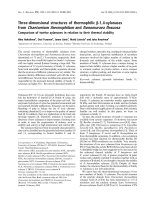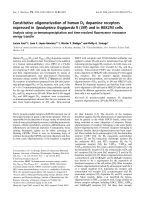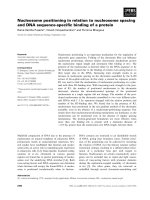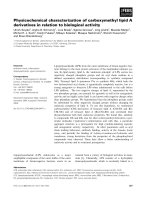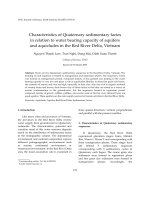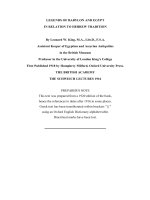Performance of cabbage (Brassica oleracea L. var. capitata) in relation to fertigation using variable rates and sources of fertilizers
Bạn đang xem bản rút gọn của tài liệu. Xem và tải ngay bản đầy đủ của tài liệu tại đây (241.68 KB, 11 trang )
Int.J.Curr.Microbiol.App.Sci (2020) 9(11): 940-950
International Journal of Current Microbiology and Applied Sciences
ISSN: 2319-7706 Volume 9 Number 11 (2020)
Journal homepage:
Original Research Article
/>
Performance of Cabbage (Brassica oleracea L. var. capitata) in Relation to
Fertigation using Variable Rates and Sources of Fertilizers
A. K. Nair*, S. S. Hebbar, M. Prabhakar, M. Senthilkumar and R. S. Rajeshwari
Division of Vegetable Crops, ICAR-Indian Institute of Horticultural Research, Hessarghatta
Lake, Bangalore, Karnataka, India
*Corresponding author
ABSTRACT
Keywords
Cabbage,
Fertigation,
Growth, Yield,
Water use
efficiency,
Economics
Article Info
Accepted:
10 October 2020
Available Online:
10 November 2020
A field experiment was conducted to study the effect of fertigation on the performance of
Cabbage variety Unnati at ICAR-Indian Institute of Horticultural Research, Bengaluru
during rabi of 2013 and 2014. The experiment was laid out in Randomized Block Design
with three replications and consisted of total ten treatments, which included different
doses, sources of fertilizers and its frequency of application. The pooled analysis of two
years data revealed that the application of fertilizer dose (150:100:125 kg NPK ha -1)
through fertigation using water soluble fertilizers on weekly interval resulted in higher
values for plant height (29.56 cm), leaves per plant (25.67) and leaf weight per plant
(599.30 gm) at 60 days after transplanting, which remained on par with the same dose and
source applied at bi-weekly interval. Similarly, these two treatments recorded higher
values for head weight (454.0 and 423.6 g), stem weight (102.3 and 94.0 g) and root
weight (66.67 and 45.67 g) at harvest. All the fertigation treatments recorded higher yields
over the conventional soil application of fertilizers to the tune of 6.5 – 60.3 per cent.
Among the fertigation treatments, application of 100 per cent recommended dose using
water soluble fertilizers at weekly interval resulted in significantly higher yield (60.86 t
ha-1) than all the other treatments tested except the treatment where the bi-weekly
application of same dose of fertilizer through the same sources (58.82 t ha -1) was done.
well as in cooked curries and pickles.
Cabbage is rich in minerals and vitamins A,
B1, B2 and C (Hanif et al., 2006).
Introduction
Cabbage is one of the most popular
vegetables grown in India. It is grown in 3.98
lakh hectares with a production of 90.37 lakh
tonnes and a productivity of 22.70 tonnes per
hectare (NHB, 2018). The major cabbage
producing states are West Bengal, Odisha,
Madhya Pradesh, Bihar, Assam, Gujarat and
Uttar Pradesh. Cabbage is used as salad,
boiled vegetable and dehydrated vegetable as
Land, water and fertilizers are the important
inputs for agricultural production systems and
special attention is required for economic and
efficient use of these limited and costly
resources. About two thirds of the increase in
production of food and fibre needed to satiate
the increase in demand of the increasing
940
Int.J.Curr.Microbiol.App.Sci (2020) 9(11): 940-950
population has been attributed to irrigation.
Drip irrigation is the most efficient system of
irrigation in terms of economising the use of
water by wetting the root zone of the crop
(Sezen et al., 2006). Vegetable production can
be made more economical and efficient by
adoption of micro irrigation methods which
increases the crop yield to the tune of 25-30
per cent with 50 to 60 per cent saving of
irrigation water over the conventional
irrigation system (Yadav et al., 1993).
medium organic carbon (0.63%), low
available N (169 kg ha-1), high available P (78
kg ha-1) and medium available K (260
kg ha-1). The soil has available water holding
capacity of 130 mm in one meter soil depth.
The experiment was laid out in Randomized
Block Design with ten treatments and three
replications. Prior to planting, a uniform
amount of farm yard manure @ 25 tonnes
hectare-1 was applied as basal application to
all the treatments as common practice. The
treatment details and quantity of different
fertilizers applied have been given in Table 1
and 2. Urea, Polyfeed (19:19:19), Sulphate of
potash and Muriate of potash were used as
water soluble fertilizers for treatments T3 to
T10, while urea, single super phosphate and
muriate of potash were used as common
fertilizers for treatments T1 and T2. The entire
dose of P and half of N and K were applied as
basal and remaining half of N and K was side
dressed to soil at in equal splits 30 and 60
days after transplanting in T1. The 30 days old
seedlings of cabbage cultivar “Unnati” were
transplanted at 80-40 x 30 cm plant to plant
spacing, under paired row system during the
first week of November during both the years.
Drip irrigation was given depending on the
rate of evaporation and amount of effective
rainfall received. It worked out to be 310 mm
and 280 mm of supplemental irrigation water
for first and second year of cropping season
after making necessary adjustment for the
effective rainfall received. The fertigation
treatments started after two weeks of planting
and fertilizers were applied through drip
system at weekly and bi-weekly interval. The
treatments were imposed dissolving desired
amounts of fertilizers and applied via venturi
system through drip irrigation to the field. A
total of 13 and 26 numbers of fertigations
were given for weekly and bi-weekly interval,
which was continued up to 15 days before
completion of crop growth period. Five plants
per replication in each of the treatments were
selected randomly for recording yield
Fertigation is an eco-friendly and sustainable
method of dispensing nutrients to the crop
near the active root zone that increases crop
productivity, quality and resource use
efficiency. It is the most effective way to
supply water and nutrients to the plant which
not only saves water but also increases yield
of fruits and vegetable (Spehia et al., 2010).
Studies have indicated that the fertilizer
should be applied regularly and timely in
small amounts for better plant growth and
yield (Neeraja et al., 1999). The cabbage crop
responded well to N and K fertigation
compared to soil application of recommended
dose of fertilizers (Vasu and Reddy, 2013).
Scientific
information
on
fertigation
especially on Rabi grown cabbage is very
less, hence the present study was undertaken
to determine the effect of fertigation of
recommended dose of fertilizers and sources
through drip irrigation for its commercial
production.
Materials and Methods
The experiment was conducted at ICARIndian Institute of Horticultural Research,
Hessarghatta, Bengaluru, Karnataka, India
during rabi of 2013 and 2014. The institute is
situated at 1307‟ N latitude, 72029‟E longitude
and an elevation of 890 meters above mean
sea level. The experimental soil was well
drained sandy loam (pH 6.60 and electrical
conductivity 0.25 dSm-1) characterized by
941
Int.J.Curr.Microbiol.App.Sci (2020) 9(11): 940-950
parameters. Recommended package of
practices including agronomic and plant
protection measures were adopted to raise the
crop (Prabhakar et al., 2010). The
experimental data were statistically analysed
(Gomez and Gomez, 1983) and compared
using critical difference at five per cent
probability level.
spread. The results are in conformity with
Rakh (1992), Sanchita et al., (2004), Singh et
al., (2006), Shinde et al., (2006) and Tanpure
et al., (2007).
The pooled data analysis revealed that T3
(application of 100 % NPK fertigation
through water soluble fertilizers at weekly
interval) recorded significantly higher number
of leaves per plant (25.67) than T1, T2 and
T10. The lowest number of leaves per plant
observed with T1 (17.67). Kapoor et al.,
(2014) and Yanglem and Tumbare (2015)
also recorded higher number of leaves at
higher levels of fertigation treatments than
soil application of fertilizer with drip
irrigation in cauliflower. Nitrogen is an
important constituent of chlorophyll and
proteins which is vital for vegetative growth.
Phosphorus and potassium play a key role in
physiological processes viz., photosynthesis,
respiration, energy storage, cell division and
cell enlargement (Sharma, 2016). Increase in
number of leaves per plant might be attributed
to balanced fertilization. Similar results have
been reported by Sharma and Sharma (2010),
Kumar et al., (2013) and Shree et al., (2014)
in cauliflower.
Results and Discussion
The data pertaining to plant growth, yield and
yield attributing characters are presented in
Table 3. The plants were taller (24.74 to 29.56
cm) and the values for plant spread where
higher (32.26 to 38.33 cm), when the water
soluble fertilizers applied through drip
irrigation in split doses compared to soil
application of fertilizers (23.59 and 30.65 cm)
at 60 days after transplanting. Application of
100 per cent recommended dose of fertilizers
through fertigation at weekly interval (T3)
recorded significantly taller plants (29.56 cm)
than most of the treatments except T4 (29.23
cm), T7 (29.34 cm) and T8 (28.80 cm).The
significantly shortest plants were observed
with soil application of common fertilizers
(23.59 cm). Similarly, T3 also recorded
significantly higher plant spread of 38.33 cm,
which remained on par with T7 i.e application
of same amount of water soluble fertilizers
through fertigation on bi-weekly basis (37.47
cm). Increased plant height and spread with
the application of 100 % fertilizer dose
(150:100:125 kg NPK ha-1) in 13 equal splits
at 7 days intervals given at different stages
might be due to availability of sufficient
quantity of major nutrients, which
subsequently resulted in higher values for
plant height and spread. Other than this,
higher frequency of irrigation and increased
availability of soil moisture under drip
irrigation coupled with fertigation might have
led to effective absorption and utilization of
these nutrients and better proliferation of
roots resulting in better plant height and
The same treatment i.e. T3 recorded
significantly higher values for leaves weight
per plant (599.3 g) than T1 (360.0g), T2
(395.0g) and T10 (429.0g). The observations
taken at the time of harvest showed that stem
and root weight was significantly higher
(102.3 and 66.67g) with application of 100
per cent fertigation of recommended dose of
macro nutrients using water soluble fertilizers
given at weekly interval (T3) than all other
treatments, which was followed by T4 and T7
(94.00 g) for stem and T4 (46.33 g) and T7
(45.67 g) for the root weight. The lower
values for stem (38.3, 45.0 g) and root (26.33,
32.67 g) were observed with soil application
of fertilizers (T1) and fertigation with
common fertilizers (T2), respectively. Naher
942
Int.J.Curr.Microbiol.App.Sci (2020) 9(11): 940-950
et al., (2014) recorded maximum root and
stem weight at the time of harvest with NPK
fertilization. This might be due to extended
split application of nitrogen and potassium
fertilizers up to 60 DAT increased the use
efficiency of added nutrients which enhanced
the uptake of these nutrients resulted more
vegetative growth.
al., (2007), Imtiyaz et al., (1999), Kumar and
Sahu (2013), Mohapatra et al., (2013), Verma
et al., (2014), Kumari et al., (2015) and
Mankar et al., (2015).
Irrespective of dosage and source of fertilizer,
fertigation treatments were significantly
superior to conventional soil application
treatment with respect to yield. All the
fertigation treatments recorded higher yields
over the conventional soil application of
fertilizers to the tune of 6.5 – 60.3 per cent.
Among the fertigation treatments, application
of 100 per cent fertilizer dose using water
soluble fertilizers at weekly interval (T3)
resulted in significantly higher yield (60.86 t
ha-1) than all the other treatments except the
treatment T7, where the bi-weekly application
of same amount of fertilizer through the same
sources (58.82 t ha-1) and T4 i.e 100 per cent
fertilizer dose, but 50 % N and K was applied
through water soluble fertilizers (56.94 t ha-1)
was done. Reducing the dosage of NK or
NPK fertigation by 25 per cent reduced the
yield substantially.
The head diameter of cabbage is a vital
parameter which influences the head size and
its market value. Larger diameter of head
fetches better market quality of cabbage as
well as processing (Table 3). The significantly
higher head diameter was recorded with T3
(13.30 cm), which remained on par with only
T4 (12.88 cm) and T7 (12.99 cm), while T1
recorded the lowest values for head diameter
(9.93 cm). Higher uptake of nutrients may
have resulted in higher diameter of head.
These results are in conformity with the
findings of Sharma et al., (2004), Shinde et
al., (2006) and Tanpure et al., (2007).
The weight of individual head is also an
important parameter which ultimately decides
the yield of the cabbage crop (Table 3). The
individual head weight was also significantly
influenced by different treatments. Most of
the fertigation treatments with application of
water soluble fertilizers remained on par with
each other. However, the maximum head
weight was observed with T3 (454.0 g)
followed by T7 (423.6 g) and T4 (357.3 g).
The treatments, T10 (238.4 g), T1 (234.0 g) and
T2 (237.3 g) had produced significantly lower
head weight than T3.
The interaction of inherent and extraneous
factors decides the yield levels of a particular
crop. It includes production and mobilization
of carbohydrates, water and nutrients uptake
from the soil and several other environmental
factors to which plants are exposed during the
growing period.
Application of nutrients through water soluble
fertilizers at different crop growth stages
helps in meeting out the nutritional
requirements which leads to better and
luxurious growth resulted in higher light
interception and photosynthates translocation
from source to sink for the enhanced yields.
These results are in agreement with those
reported by Shinde et al., (2006) in cabbage,
Kapoor et al., (2014), Chetan and Singh
(2011) in cauliflower and Nair et al., (2017)
in okra.
Increased nutrient availability in the root zone
due to optimum nutrition levels leads to
greater absorption and translocation of
minerals and nutrients and finally increased
accumulation of photosynthates by plants,
might be the reasons for higher head weight.
These results are corroborated with the
findings of Shinde et al., (2006), Tanpure et
943
Int.J.Curr.Microbiol.App.Sci (2020) 9(11): 940-950
Table.1 Fertigation treatment details in cabbage
Symbol
Treatment
Fertilizer
Application dose
Common
100 % soil
application
75:100:62.5
Common
50 % NK fertigation
75:100:62.5
T3
WSF
100 % NPK
fertigation
T4
WSF
50 % NK fertigation
75 % fertilizer dose
(112.5:75:93.75 kg
ha-1)
WSF
100 % NPK
fertigation
WSF
50 % NK fertigation
100 % fertilizer dose
(150:100:125 Kg ha-1)
WSF
100 % NPK
fertigation
WSF
50 % NK fertigation
WSF
100 % NPK
fertigation
WSF
50 % NK fertigation
T1
T2
T5
T6
T7
100 % fertilizer dose
(150:100:125 Kg ha-1)
T8
T9
T10
75 % fertilizer dose
(112.5:75:93.75 kg
ha-1)
WSF: Water soluble fertilizers
944
Basal dose
(kg ha-1)
75:100:62.5
56.25:75:46.8
7
75:100:62.5
56.25:75:46.8
7
Top
dressing
(kg ha-1)
Fertigaton
(kg ha-1)
Frequency
75:100:62.5
-
-
75:0:62.5
Weekly
150:100:125
Weekly
75:0:62.5
Weekly
112.5:75:93.7
5
Weekly
56.25:0:46.87
Weekly
150:100:125
Bi-weekly
75:0:62.5
Bi-weekly
112.5:75:93.7
5
Bi-weekly
56.25:0:46.87
Bi-weekly
Int.J.Curr.Microbiol.App.Sci (2020) 9(11): 940-950
Table.2 Treatment wise fertilizers applied (Kg ha-1) under fertigation in cabbage
Treatments
Basal dose
Urea
Single super
phosphate
625.0
625.0
0.0
625.0
0.0
90.0
0.0
625.0
0.0
90.0
163.0
163.0
0.0
163.0
0.0
67.5
0.0
163.0
0.0
67.5
T1
T2
T3
T4
T5
T6
T7
T8
T9
T10
Top dressing
Muriate
of potash
104.0
104.0
0.0
104.0
0.0
45.0
0.0
104.0
0.0
45.0
Urea
Fertigation
Muriate
of potash
104.0
163.0
Urea
163.0
109.0
163.0
81.0
122.0
109.0
163.0
81.0
122.0
Muriate of
potash
104.0
Sulphate of
potash
50.0
125.0
38.0
94.0
50.0
125.0
38.0
94.0
Table.3 Growth and yield parameters of cabbage as influenced by fertigation treatments (Pooled data)
Treatment
T1
T2
T3
T4
T5
T6
T7
T8
T9
T10
CD
(P=0.05)
At 60 DAT
Plant
Plant
height
spread
(cm)
(cm)
23.59
24.74
29.56
29.23
28.76
26.01
29.34
28.80
26.82
26.09
0.780
30.65
32.26
38.33
34.27
33.77
32.46
37.47
34.61
33.82
32.53
3.26
Leaves
per
plant
17.67
18.67
25.67
25.00
23.33
21.67
25.33
23.67
22.33
20.00
4.59
Leaves
weight
per plant
(g)
360.0
395.0
599.3
586.0
541.6
459.7
583.3
568.6
539.0
429.0
140.16
Head
weight
(g)
At harvest
Head
diameter
(cm)
234.0
237.3
454.0
357.3
341.0
288.3
423.6
351.7
338.0
238.4
187.7
9.93
10.76
13.30
12.88
11.96
11.72
12.99
12.43
11.78
11.51
0.472
945
Stem
weight
(g)
Root
weight
(g)
Yield (t
ha-1)
38.3
45.0
102.3
94.0
73.3
70.0
94.0
88.3
72.7
65.6
28.79
26.33
32.67
66.67
46.33
39.00
34.33
45.67
44.33
37.33
33.33
13.35
37.96
40.39
60.86
56.94
52.59
51.74
58.82
52.41
49.72
47.06
4.06
WUE
(kg/ha-mm)
FUE
(Kg/kg)
79.08
84.14
126.79
118.62
109.56
107.79
122.54
109.18
103.58
98.04
101.23
107.71
162.29
151.84
187.15
184.13
156.85
139.76
176.94
167.47
19 All
526.0
395.0
526.0
395.0
-
Int.J.Curr.Microbiol.App.Sci (2020) 9(11): 940-950
Table.4 Economics of cabbage crop in relation to fertigation treatments
Treatment
T1
T2
T3
T4
T5
T6
T7
T8
T9
T10
Average
Yield (t ha-1)
37.96
40.39
60.86
56.94
52.59
51.74
58.82
52.41
49.72
47.06
Gross
Investment (Rs. ha-1)
160822
160822
190800
166437
180587
162296
190800
166437
180587
162296
Gross income
(Rs. ha-1)
379600
403900
608600
569400
525900
517400
588200
524100
497200
470600
Sale Price = Rs.10.00/kg
946
Net income
(Rs. ha-1)
218778
243078
417800
402963
345313
355104
397400
357663
316613
308304
Benefit :cost ratio
1.36
1.51
2.19
2.42
1.91
2.19
2.08
2.15
1.75
1.90
Int.J.Curr.Microbiol.App.Sci (2020) 9(11): 940-950
Application of 100 per cent fertilizer dosage
through water soluble fertilizers at weekly
(T3) or bi-weekly (T7) interval did not bring
significant differences in head yield of
cabbage crop and it remained same with 75
per cent of the dosage i.e. T5 and T9.
However, reducing the dosage by 25 per cent
and applying it through water soluble
fertilizers at weekly or bi-weekly interval
made a significant difference in yield levels.
Similarly, significant differences were
recorded between application of 50 per cent
of NK amount at 100 and 75 per cent fertilizer
dosage through fertigation at weekly as well
as bi-weekly intervals.
Fertilizer use efficiency
Though the T3 recorded highest yield (60.86 t
ha-1) and water use efficiency (126.79 kg/hamm), the application of 25 per cent less
amount of fertilizer dosage in the form of
water soluble fertilizes given either 100 per
cent NPK of 50 per cent NK on weekly and
bi-weekly basis through fertigation resulted in
higher fertilizer use efficiency (167.47 to
187.15 kg/kg). Soil application or fertigation
with normal fertilizers gave the minimum
values for fertilizer use efficiency of 101.23
and 107.71 kg/kg. Vasu and Reddy (2013)
also recorded higher fertilizer use efficiency
at lower rate of fertilizer dose in cabbage.
Water Use Efficiency
Economics
Data pertaining to water use efficiency in
cabbage is presented in Table 3. It is clearly
evident from the results that all the fertigation
treatments using water soluble fertilizers
produced higher water use efficiency to the
tune of 6.39 to 60.33 per cent compared to
conventional method of fertilizer application
(79.08 kg/ha-mm). Among fertigation
treatments,T3 i.e. application of 100 per cent
NPK fertigation using water soluble fertilizers
on weekly basis, recorded the highest water
use efficiency of 126.79 kg/ha-mm followed
by same amount of fertilizer given on biweekly basis (T7 :122.54 kg/ha-mm). This
was mainly due to maximum cabbage head
yield recorded with same amount of irrigation
water used. This is in confirmation with the
findings of Kapoor et al., (2014) in
cauliflower, Chand (2014) in salad cucumber,
Soumya et al., (2008) in tomato, Mahendran
et al., (2011) and Nair et al., (2017) in okra.
Cutting across the level and frequency of
fertigation, NPK fertigation in general
resulted in marginally superior water use
efficiency (109.18 - 126.79 kg/ha-mm) over
NK fertigation treatments (98.04 - 109.56
kg/ha-mm).
The averaged data pertaining to economic
returns and benefit: cost ratio related to
„Unnati‟ a cultivar of cabbage for the year
2013 and 2014 are given in Table 4. All the
fertigation treatments with water soluble
fertilizers resulted in higher gross income
than soil application (T1) and fertigation with
common fertilizers (T2). Among the
fertigation treatments, application of 100 per
cent fertilizer dose through fertigation on
weekly basis (T3) has resulted in highest gross
income (Rs.608600 ha-1) followed by T7 i.e.
same amount of fertilizer given on bi-weekly
basis (Rs.588200 ha-1). As far as net income
is concerned, the higher values were recorded
with T3 (Rs.417800 ha-1) and T4 (Rs.402963
ha-1). Fertigation of 50 per cent amount of N
and K of the 100 per cent fertilizer dose
through water soluble fertilizers (T4) has
recorded the highest B:C ratio of 2.42. This is
mainly due to less gross investment coupled
with moderately higher levels of yield
compared to other treatments. Because of this,
in other treatments, wherever 50 per cent
amount of N and K applied through
fertigation and reaming 50 per cent through
soil application resulted in moderately higher
947
Int.J.Curr.Microbiol.App.Sci (2020) 9(11): 940-950
B:C ratio, which ranged from 1.90 to 2.19,
irrespective of weekly or bi-weekly
applications. Vasu and Reddy (2013) and
Bhoutekar et al., (2017) recorded higher B:C
ratio with higher doses of fertilizer where the
N and K was given through fertigation in
cabbage and cauliflower, respectively. Nair et
al., (2017) also observed the same results in
okra.
Hanif, R., Iqbal, Z., Iqbal, M., Hanif, S. and
Rasheed, M. 2006. Use of vegetables
in food: Role in human health. J.
Agril. and Bio. Sci., 1, 18-22
Imtiyaz, M., Mgadla, N. P. and Manase, S.
K.1999. Drip irrigation scheduling for
cabbage under semi-arid climate.
Trop. Agril., 78(2): 99-103.
Kapoor, Renu, Sandal, Sanjeev K., Sharma,
Sanjay K., Kumar Anil and Saroch
Kapil. 2014. Effect of varying drip
irrigation levels and NPK fertigation
on soil water dynamics, productivity
and water use efficiency of cauliflower
(Brassica oleracea var. Botrytis) in
wet temperate zone of Himachal
Pradesh. Indian J. Soil Cons., 42: 249254
Kumar, P. and Sahu, R. L. 2013. Effect of
irrigation and fertigation levels on
cabbage. Asian. J. Soil Sci., 8 (2): 270274.
Kumar, S., Singh, J. P., Rajbeer, R. N.,
Mohan, B., Kaushik, H. and Kumar,
D.2013. Influence of integrated
nutrient management on growth and
yield of cauliflower (Brassica
oleracea var. botrytis L.), Int. J. Agric.
Sci. 9(2):747-749
Kumari, C., Mankar, A., Karuna, K., Solanki,
S. S. and Singh, V. K. 2015. Effect of
different levels of nitrogen and
microbial inoculants on yield and
quality of cabbage. Indian J. Agri.
Sci., 85(4): 515-518.
Mahendran, P. P., Arulkumar, D., Gurusamy,
A. and Kumar, V. 2011. Performance
of nutrient sources and its levels on
hybrid bhendi under drip fertigation
system. In: Innovation in technology
and management of micro-irrigation
for crop production enhancement. 8th
International
Micro-irrigation
Congress under 21st International
Congress on Irrigation and Drianage,
16-21 October 2011, Tehran, Iran.
From this study it can be concluded that
application of water soluble fertilizers
@150:100:125 kg NPK ha-1 during the
cropping period through fertigation at weekly
intervals resulted in higher yield and net
income in rabi grown cabbage. However,
higher B:C ratio was obtained with fertigation
of 75:0:62.5 NPK ha-1 at weekly intervals
along with soil application of 75:100:62.5
NPK ha-1 as basal dose.
References
Bhoutekar Savita, Saikia Luchon, Gogoi
Bonti and Chack Sonbeer. 2017.
Fertigation level and mulching in
cauliflower (Brassica oleracea L. var.
botrytis)
cv.
Snowball
white.
International J. of Agri. Sci., 9(21):
4226-4228
Chand, A.R.J. 2014. Nutrient use efficiency
and economics of salad cucumber
using drip fertigation in naturally
ventilated polyhouse. J. Agri. and Vet.
Sci., 7(12): 22-25.
Chetan, S. and Singh, K.G. 2011. Crop water
requirements and fertigation options
for early drip irrigated cauliflower
(Brassica oleracea var. botrytis Linn.)
grown in a greenhouse. Prog. Hort.,
43(1): 99-101.
Gomez, K. A. and Gomez, A, A, 1983.
Statistical procedure for agricultural
research. Second edition. WileyInternational Science Publication. New
York, United States of America.
948
Int.J.Curr.Microbiol.App.Sci (2020) 9(11): 940-950
Mankar, A., Kumari, C. and Karuna, K. 2015.
Effect of nitrogen levels and microbial
inoculants on growth, yield and quality
of cabbage. Prog. Hort., 47(2): 296299.
Meena,
Yogendra,
Sharma,R.K.,
Kushwah,S.S.
and
Gallan,
Roshan.2017.Effect of varieties and
nutrient levels on growth and yield of
cauliflower (Brassica oleracea var
botrytis L.). The Bioscan, 12(3): 17311734
Mohammadullah Nikzad, J. S. Aravinda
Kumar,
M.
Anjanappa,
H.
Amarananjundeswara,
B.
N.
Dhananjaya and Basavaraj, G. 2020.
Effect of fertigation, levels on growth
and yield of cabbage (Brassica
oleracea L. var. capitata). Int. J. Curr.
Microbiol. App. Sci. 9(01): 1240-1247
Naher, M. N. A., Alam M. N. and Jahan,
N.2014.
Effect
of
nutrient
management on the growth and yield
of cabbage (Brassica oleracea var.
capitata L.) in Calcareous Soils of
Bangladesh. The Agriculturists 12(2):
24-33
Nair, A.K., Hebbar, S.S., Prabhakar, M. and
Rajeshwari, R.S. 2017. Growth and
yield
performance
of
okra
(Abelmoschus
esculentus
(L.)
Moench.) in relation to fertigation
using different rates and sources of
fertilizers. Int. J. Curr. Microbiol.
App. Sci., 6 (8): 137-143
National Horticulture Board. 2018. Indian
Horticulture Database. Ministry of
Agriculture, Government of India.
Neeraja, G., Reddy, K. M., Reddy, I. P. and
Reddy, Y. N. 1999. Effect of irrigation
and nitrogen on growth, yield and
yield attributes of Rabi onion (Allium
cepa) in Andhra Pradesh. Veg. Sci.,
26: 64-68.
Prabhakar, M., Hebbar, S. S. and Nair, A. K.
2010.Production
technology
of
vegetable crops- A hand book. Indian
Institute of Horticultural Research,
Hessarghatta, Bangalore, Karnataka,
pp 87-92.
Rakh, A. J. 1992. Efficiency of liquid
fertilizer through drip and surface
irrigation method in cabbage (Brassica
oleraceae var. capitata L.) in Entisols.
M.Sc. (Agri.) Thesis submitted to
Mahatma Phule Krishi Vidyapeeth,
Rahuri, Maharashtra.
Sanchita, B., Phookan, D. B., Kachari, M.,
Hazarika, T. K. and Das, K. 2004.
Growth, yield and economics of
broccoli under different levels of
nitrogen fertigation. Hort. Sci., India.
67: 279-282.
Sezen, S.M., Yazar, A. and Eker, S. 2006
Effect of drip irrigation regimes on
yield and quality of field grown bell
pepper. Agric. Water Manage., 81(12):115-13
Sharma, K.C. and Sharma, L. K. 2010. Effect
of bio-fertilizers and NPK levels on
growth and yield of mid-maturity
group of cauliflower under mid hill
sub- humid conditions of Himachal
Pradesh. J. Hill Agric., 1 (1) :19-22.
Sharma, V. 2016. Effect of nutrient
management on growth and yield of
cauliflower (Brassica oleracea var
botrytis) inside low cost polyhouse.
Himachal J. Agric. Res., 42 (1): 88-92.
Shinde, P. P., Chavan, M. G. and Newase, V.
B. 2006. Studies on fertigation in
cabbage. J. Maharashtra Agric. Univ.,
31(3): 255-257.
Shree, S., Singh, V. K. and Kumar R.
2014.Effect of integrated nutrient
management on yield and quality of
cauliflower (Brassica oleracea var.
botrytis L.). The Bioscan. 9 (3): 10531058
Singandhupe, R.B., James. B.K., Edanna,
Anthony, Nanda, P. and Behera, M.S.
2007. Response of fertigation and
949
Int.J.Curr.Microbiol.App.Sci (2020) 9(11): 940-950
mulching on growth and fruit yield of
pointed gourd (Trichosanthes dioica).
Indian J. Agric. Sci., 77(1): 8-13.
Singh, R., Chaurasia, S. N. S. and Singh, S.
N. 2006. Response of nutrient sources
and spacing on growth and yield of
broccoli (Brassica oleracea var.
italica Plenck). Veg. Sci., 33 (2): 198200.
Singh, S. K., Singh, T., Singh, B. N. and
Verma, R. B. 2004.Response of
fertility levels and plant density on
growth, yield and quality of hybrid
cabbage. Veg. Sci., 31(1): 69-72.
Soumya, T. M., Ramachandrappa, B. K. and
Nanjappa, H. V. 2008. Effect of
fertigation with different sources and
levels of fertilizer on growth and yield
of tomato. Mysore J. Agril. Sci., 43(1):
80-84.
Spehia, R. S., Sharma, I. P. and Bhardwaj, R.
K. 2010. Cost economics and effect of
drip irrigation on yield and water use
efficiency of okra under mulch and
non mulch conditions in mid-hills of
Himachal Pradesh. Haryana J. Hort.
Sci., 39 (1 & 2): 161-164.
Tanpure, S. N., Patil, P. V., Pingale, L.V.,
Gutal, G. B. and Bote, N. L.
2007.Effect of different levels of
fertilizer application on yield of
cabbage. J. Maharashtra Agric. Univ.,
32(1): 151-152.
Vasu, D. and Reddy, M.S.2013. Effect of
fertigation on yield, quality, nutrient
uptake, fertilizer and water use
efficiency in cabbage (Brassica
oleracea), Agropedology, 23 (2): 106112
Verma, H. and Nawange, D. D., 2015, Effect
of different levels of nitrogen and
sulphur on the growth, yield and
quality of cabbage (Brassica oleracea
L. var. capitata). Agric. Sci. Digest.,
35(2): 152-154.
Yadav, B.S., G.R. Singh, J.L. Mangal and
V.K. Srivastava. 1993. Drip irrigation
in vegetable production. Agric. Res. J.
14 (2): 75-82.
Yangalam, S.D and Tumbare, A.D. 2015.
Response of cauliflower (Brassica
oleracea var. botrytis) to varying
irrigation regimes and fertigation
levels. Trends in Biosciences, 8 (22):
6110-6115.
How to cite this article:
Nair, A. K., S. S. Hebbar, M. Prabhakar, M. Senthilkumar and Rajeshwari, R. S. 2020.
Performance of Cabbage (Brassica oleracea L. var. capitata) in Relation to Fertigation using
Variable Rates and Sources of Fertilizers. Int.J.Curr.Microbiol.App.Sci. 9(11): 940-950.
doi: />
950


